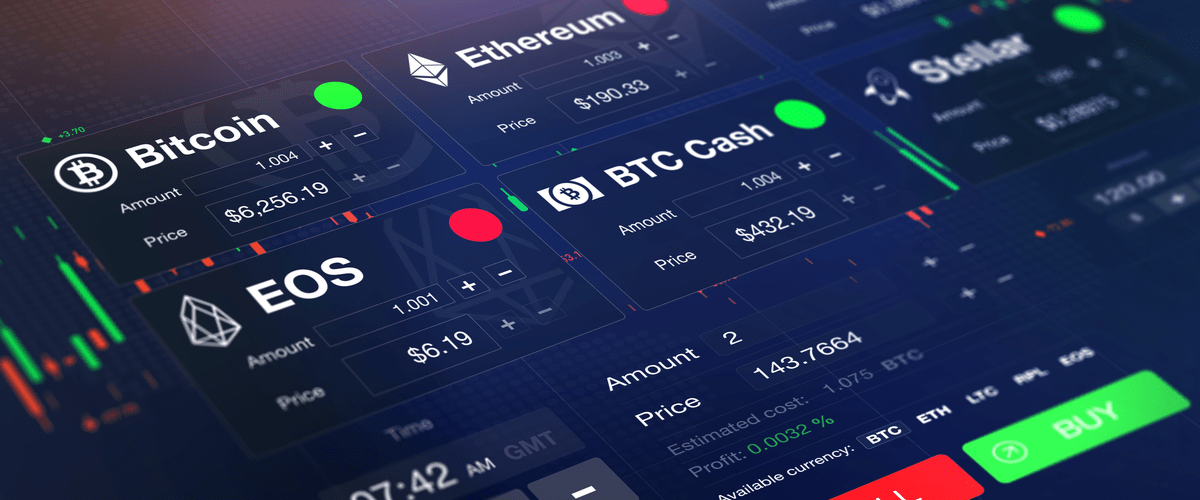
Crypto CFD Trading Explained
Cryptocurrencies are the youngest asset class in which it is possible to trade with CFDs . Trading with CFDs on cryptocurrencies is also called Crypto CFD Trading .
Cryptocurrency is known by different names, including crypto currency, crypto coins and crypto money. The most famous coin is Bitcoin. This cryptocurrency has increased by a factor of 8 in just one year. If you had bought 1,000 euros in Bitcoin CFDs with 5x leverage a year ago, you would now have 40,000 euros in your portfolio. Bitcoin is far from the only cryptocurrency. Some other coins have achieved even better results. Want to know more about trading CFDs on Bitcoin? Then read our article: ‘ Bitcoin CFD ‘.
CFD stands for Contract For Difference and is a powerful, simple and flexible trading instrument that can be extremely suitable for effectively executing a crypto trading strategy.
Cryptocurrencies are highly volatile , so caution is advised. When trading cryptos via a CFD, your capital is at risk. Before we go further into trading CFDs on crypto, it is important to know what cryptocurrencies are.
Crypto CFD Trading Explained
Cryptocurrencies are the youngest asset class in which it is possible to trade with CFDs . Trading with CFDs on cryptocurrencies is also called Crypto CFD Trading .
Cryptocurrency is known by different names, including crypto currency, crypto coins and crypto money. The most famous coin is Bitcoin. This cryptocurrency has increased by a factor of 8 in just one year. If you had bought 1,000 euros in Bitcoin CFDs with 5x leverage a year ago, you would now have 40,000 euros in your portfolio. Bitcoin is far from the only cryptocurrency. Some other coins have achieved even better results. Want to know more about trading CFDs on Bitcoin? Then read our article: ‘ Bitcoin CFD ‘.
CFD stands for Contract For Difference and is a powerful, simple and flexible trading instrument that can be extremely suitable for effectively executing a crypto trading strategy.
Cryptocurrencies are highly volatile , so caution is advised. When trading cryptos via a CFD, your capital is at risk. Before we go further into trading CFDs on crypto, it is important to know what cryptocurrencies are.
What are cryptocurrencies?
Cryptocurrency can be seen as digital money. These virtual coins exist in a decentralized computer network and are not backed by any underlying value, except the trust that people have in this new form of money. Because there is no central bank or government that issues crypto money, there is no one who can manipulate this process from the outside. The only way to create the currency is within the computer network.
This is done by means of the blockchain, a virtual ledger in which all transactions that have ever been done with a cryptocurrency can be found. This ledger is updated every few minutes with the latest transactions. These new transactions together form a ‘block’, which is in turn linked to the previous block. Hence the name blockchain.

Every new block is created by miners. Miners are powerful computers that provide large amounts of computing power to keep the blockchain secure. The system is not easy to manipulate, because no one can predict in advance which miner will generate the next block. Mining Bitcoin is very lucrative, because miners receive a reward in the form of coins if they add a correct block to the chain.
With the help of the blockchain it is possible to check exactly how much crypto is in the account of each participant and where it comes from. This makes cryptocurrencies theoretically many times more transparent than normal bank accounts. However, it is not possible to determine which account numbers are owned by which persons. The only person who can spend the money in the account is the person who has the private key. This is a kind of password. This makes the blockchain anonymous in practice.
Trading in cryptocurrency
Due to their high volatility, cryptocurrencies such as Bitcoin and Ethereum are very attractive for active investors and CFD traders. It is not unusual for a crypto coin to rise or fall by more than 5% within a day. The price can easily fluctuate by more than 20% within a week. This makes the opportunities great for active investors and day traders.
Cryptocurrencies are traditionally traded on specific ‘ exchanges ‘. These exchanges do have some disadvantages compared to CFD trading. Often the exchanges are slow, it is difficult to deposit money and you cannot trade with leverage or short. In addition, many exchanges are not regulated. In the past there have been problems with hackers, causing users who had their crypto on large exchanges such as Bitfinex and Mt. Gox to lose their money.
CFDs offer more convenience. Traders can go long or short and trade with or without leverage. It is possible to buy CFDs on Bitcoin, Ethereum and other cryptocurrencies. With exchanges you own the coin(s), with CFD this is not the case. With CFD trading you speculate purely on the price movement of an underlying product.
This is how crypto CFD cryptocurrency trading works
It is much easier to speculate on various cryptocurrencies using one CFD trading environment. You can immediately start trading commission-free, for example, a Bitcoin, Ethereum, Litecoin or Ripple CFD. This requires a small deposit into your account. It is wise to compare different brokers and start small.
Potential Benefits of Trading Cryptos with CFDs
By means of a CFD, the investor can trade certain desired positions in cryptocurrencies, without owning the underlying asset. This makes it easy to take various positions to use leverage.
There are several problems with the current cryptocurrency exchanges. For example, these platforms are primarily targeted by hackers. The exchanges are, as it were, a kind of crypto banks. When hackers succeed here, they are in. Hackers try to plunder the accounts of the exchange, because the crypto money that investors have sent to the exchange wallet of a exchange is not under their own control. The aforementioned private keys are therefore not under their own control, which means that investors are, as it were, at the mercy of the good practices of the exchange and must trust that this is an honest and good company. It is very unwise to leave crypto on the exchange when it is not being traded. Anyone who goes long is best advised to safely store the cryptocurrency on a hardware wallet.
Finally, many crypto exchanges are small and young companies with a young development history. It still happens too often that the exchange is offline due to unexpected busyness. This can result in losses or cause additional returns to be missed because positions are not closed or opened in time.

The Benefits of a CFD Trading Exchange
A specific CFD trading platform is designed to allow the investor to open and close positions as quickly and efficiently as possible with a certain leverage. Thanks to the long history of development, ease of use is central. The investor can profit as much as possible from the volatility of cryptocurrencies, without having to have crypto money himself. When using leverage, there must be a minimum cover on the trading account as collateral. This is known as the margin.
CFDs make it possible to open a virtual position. This is a contract between the broker and the investor. The difference between the opening and closing position is settled between both parties. When the investor has closed his closing position with a loss, the deposit is used in the settlement. An example will clarify this further.
The investor chooses the direction to invest in (buy or sell). The buttons buy or sell respectively contain the points that must be passed for a successful trade. Suppose the number in a Bitcoin buy position is 4.5890, then the trade must be higher than this number at closing to be considered successful. You can trade in many different cryptocurrencies with CFDs, the best known of which is Bitcoin.
Bitcoin: de first mover
Bitcoin is the first cryptocurrency. The blockchain is a relatively new invention that was first introduced in 2008 by Satoshi Nakamoto. Nakamoto is the pseudonym of the anonymous inventor(s). Shortly after the introduction of the blockchain, Bitcoin was born. Where in the beginning only a few miners were busy validating the blocks and there were hardly any transactions, the value of bitcoin was almost zero. Over the years, however, interest increased. More and more people made computer power available as miners and the first progressive companies started accepting bitcoins as a means of payment. The price of Bitcoin rose sharply amid fears about the stability of fiat currencies such as the dollar and the euro. In 2013, the price shot up from around $15 to over $1,200 per coin. However, the price collapsed again to around $200 in early 2015 after government intervention, a few hacks and the closure of Mt. Gox. This was the largest Bitcoin at the time.

Interest in Bitcoin remained limited for 18 months and the price remained fairly stable. Halfway through 2016, the crypto coin began a new advance. Possible causes of the renewed interest were online companies that started accepting BTC payments, the American elections and positive regulations in several countries including Japan.
Bitcoin made a huge rally with a peak of $20,000 in December 2017. This ATH (all time high) has now been broken. The new price record (at the time of writing) is $41,999. This can change quickly, because as mentioned before, Bitcoin is very volatile.
Andere cryptocurrencies
Bitcoin is not the only cryptocurrency that you can invest in with CFDs. There are a large number of alternative cryptocurrencies, or altcoins, to be found. Many of these added little, causing these altcoins to lose their value in a short time. However, the cryptocurrencies below actually offer something new or extra, causing these coins to see their own price explosion. Read more about different crypto coins here .
Bitcoin is compared to gold and Litecoin to silver. This clone of Bitcoin has been around since 2013. Litecoin works with a different security algorithm. In addition, Litecoin generates blocks four times faster than Bitcoin, making transactions faster and cheaper. They may be less secure. The price of Litecoin has risen from around $4 to $150 in recent years.
Ethereum (ETH) is also increasingly in the spotlight. This crypto project plays an important role in the world of Decentralized Finance. Ethereum is a decentralized computer, on which in theory every conceivable application can be run. Computing power on this computer is paid in the tradable ETH. In 2020, the price of ETH rose from around $150 to over $1660 in early 2021.
Monero ‘s USP is that it is an open-source anonymous cryptocurrency. With Bitcoin, all transactions in the blockchain are completely transparent. However, money sent via Monero cannot be traced. This makes Monero popular with criminals and in 2016 this crypto was widely used on darknet marketplace Alphabay. The value of this cryptocurrency rose to $150 in January 2021 despite its shady use.
Ripple can best be described as an online peer-to-peer payment network. This platform brings together supply and demand in all conceivable currencies. Ripple does this both between banks and individuals. In addition, Ripple has its own currency that works as a universal medium of exchange within the system.
Crypto CFD Trading: The Best Crypto Brokers
Wondering where to trade cryptocurrency CFDs? Easily compare the best crypto CFD brokers. All these trading environments work great, but it is personal which broker suits your needs best. So compare them and take a look to find out which crypto broker suits you best.
Our reading tips
for the novice investor
